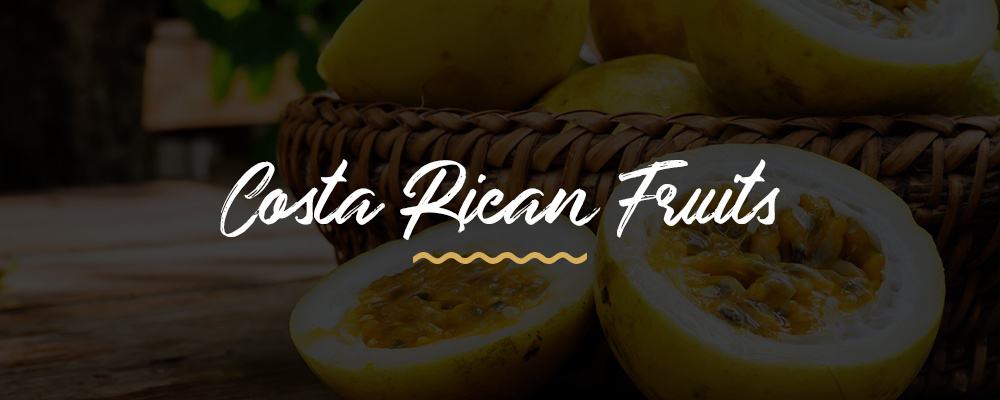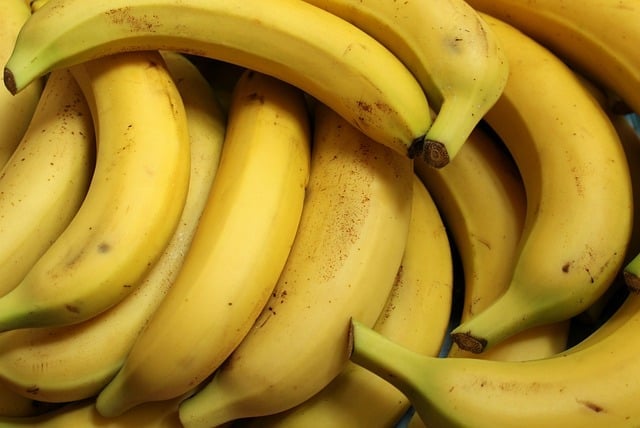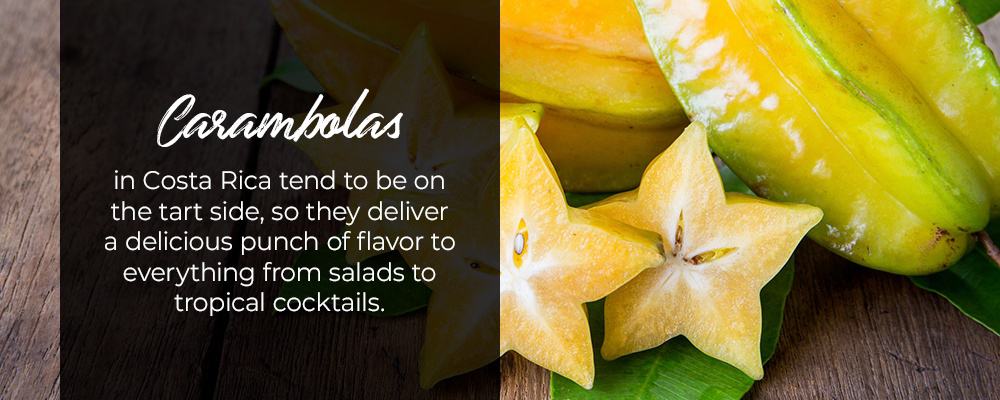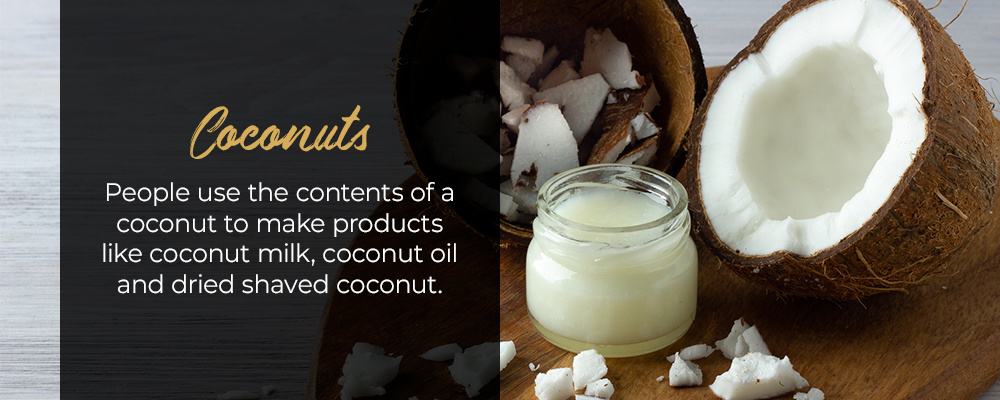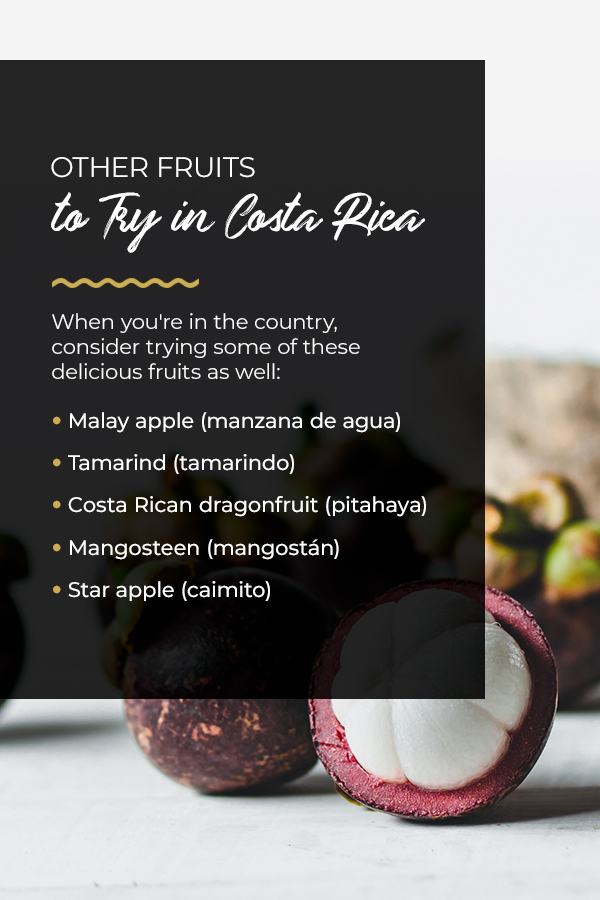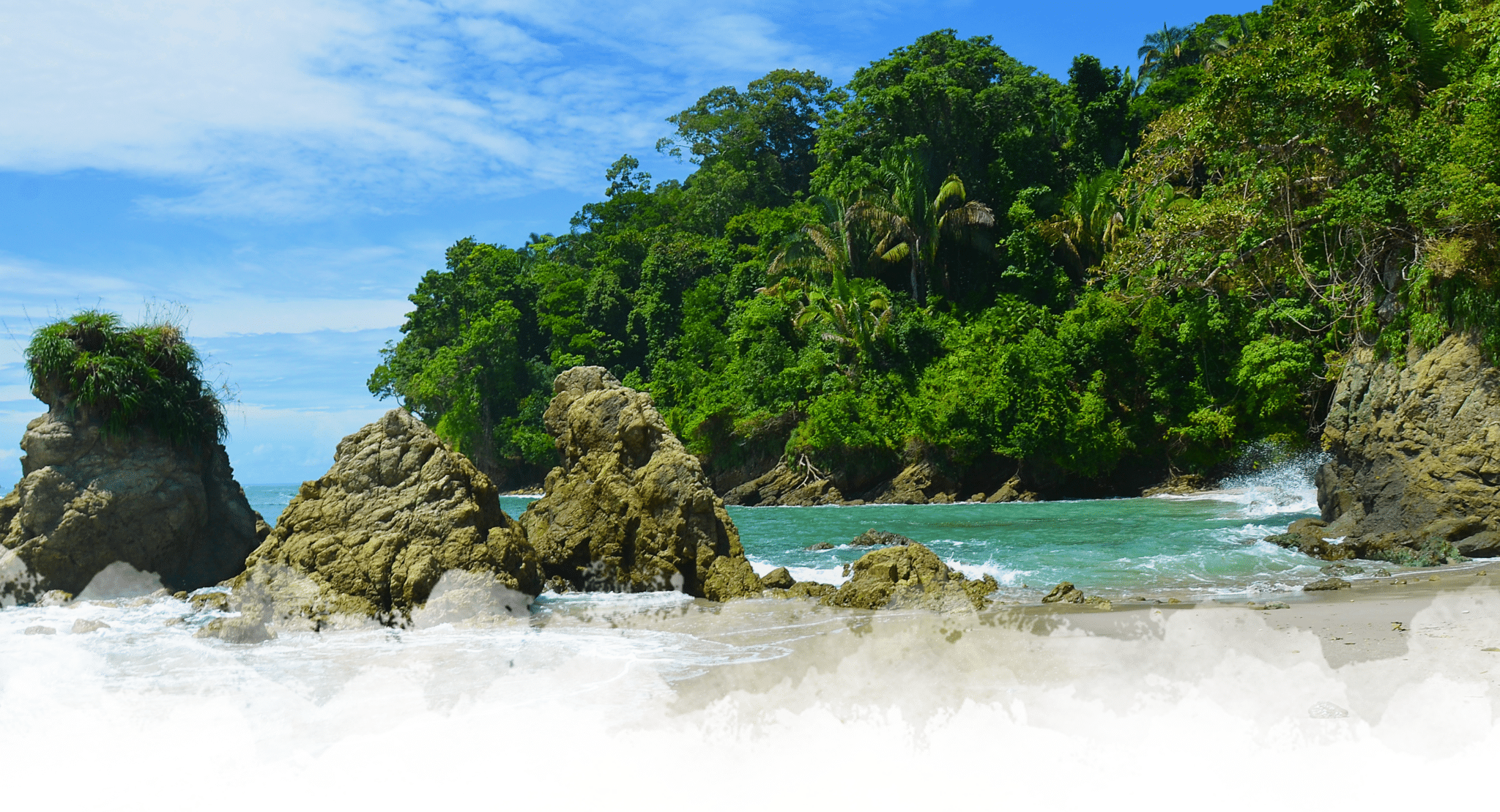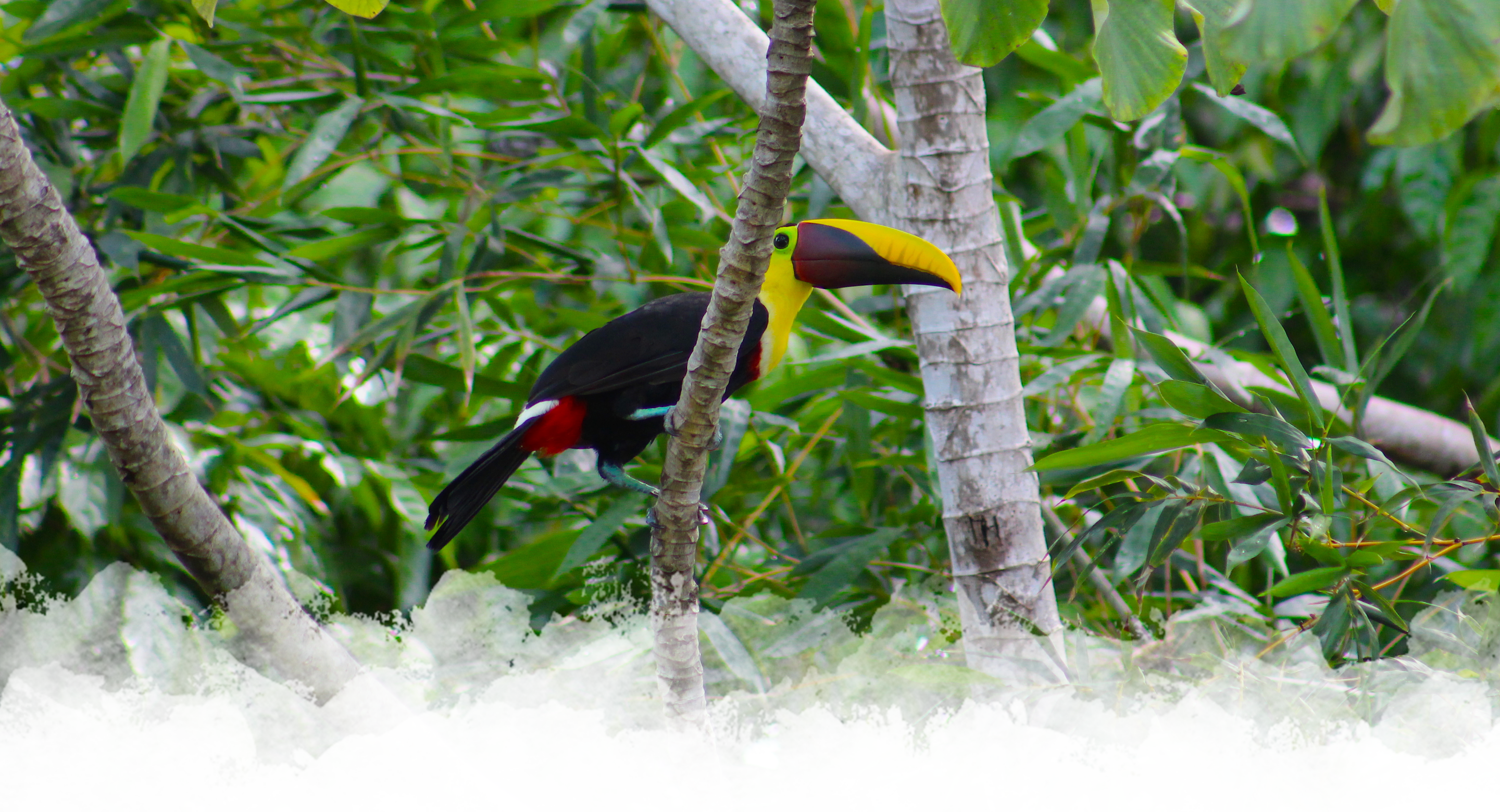Must-Try Costa Rican Fruits
Costa Rica is a lush country that is dense with vegetation. In Costa Rican supermarkets and farmer’s markets, you’ll find an array of tropical fruits that are a feast for the eyes as well as the taste buds. If you’re planning a trip to Costa Rica and you love fruit, you’re likely to find fruits you’ve never tried and possibly have never heard of before.
What Fruits Does Costa Rica Produce?
Even if you’re not planning a trip, you may want to after imagining yourself biting into juicy tropical fruits in San Jose or sipping an exotic fruit mimosa from your private balcony as you look out over a dazzling beach. During your stay in this beautiful country, look out for these native fruits of Costa Rica.
1. Pineapple
More than 47% of exported pineapples come from Costa Rica, making it the world’s largest pineapple exporter. Many people associate pineapples with Hawaii, but the reality is that Costa Rica exports pineapples to Hawaii.
It takes 20 to 26 months to grow a pineapple, and each plant only produces one fruit, so a lot of time and care goes into every pineapple you eat. If you enjoy pineapple, you’ll be blown away by the incredible taste of Costa Rican pineapples.
In Costa Rica, you can also try the Pinkglow™ pineapple — a genetic variant that has been carefully curated over time. As the name suggests, the flesh of this pineapple is pink. This delicacy is exported to the finest fruit markets at a premium that signifies just how special it is.
Costa Ricans enjoy pineapple in a variety of ways. The fruit is delectable on its own, mixed in with other tropical fruits or juiced. Pineapple juice is also a flavorful addition to fruit smoothies and alcoholic drinks like the Pura Vida, named after the greeting Costa Ricans exchange. In a Colada Fresca, a twist on the Piña Colada, you’ll get chunks of fresh pineapple. However you enjoy it, pineapple delivers some impressive health benefits, such as shortening infections and strengthening your bones.
2. Passion Fruit
In Costa Rica, you’ll find two varieties of passion fruit: maracuyá and granadilla. You can tell the difference between these fruits right away by looking at the exterior. The exterior of a maracuyá is purplish-green and wrinkly when ripe, while a granadilla has a harder, orange exterior. A maracuyá and granadilla are similar in size, but granadillas are much lighter.
Both of these passion fruits contain a gelled pulp and black seeds. This inner portion of the fruit is the edible part. In a maracuyá, the pulp is a vivid orange, and in a granadilla, it is nearly transparent.
Passion fruit has a sweet, tangy taste and is delicious on its own or included in smoothies, yogurt and desserts. The simplest way to enjoy this fruit is to puncture the outside and slurp up the succulent seed filling. Many Costa Ricans blend up the inside of the fruit and strain it to make a flavorful, smooth juice. Passion fruit is a great source of nutrition since it’s rich in vitamins, antioxidants and fiber.
3. Bananas
Bananas are Costa Rica’s main export. The banana industry is a vital part of Costa Rica’s economy and employs many people in rural areas of the country. Bananas are a popular fruit in the U.S. and other countries, but many people are used to imported bananas. In Costa Rica, you can enjoy bananas that are grown locally.
Bananas grow on plants that are technically herbs — not trees. These plants produce clusters of banana fruits. The clusters are called hands, and the individual bananas are called fingers. Bananas are easy to peel and enjoy without any fanfare, but you can also add banana slices to your breakfast or to a smoothie to make it sweeter and creamier. Plantains, a cousin to yellow bananas, are often sliced, fried and served as a side dish in Costa Rica.
Bananas offer a host of nutrients, but they’re best known for being rich in potassium. This mineralaids in many processes in our bodies, including maintaining fluid levels, regulating the movement of material in and out of cells and maintaining a regular heartbeat.
4. Rambutan
Another Costa Rican fruit that has its origins in Southeast Asia is the rambutan. The Costa Rican rambutan is called a mamón chino, which translates to Chinese lollipop or sucker. You’ll see piles of these small, spiky, red fruits at street stands and in supermarkets during these times.
The mamón chino taste is mildly sweet, with a touch of tartness. Though the outside is bright in color, the flesh inside is translucent, similar to a grape. These fruits also share a similar texture and taste to a white grape. Costa Ricans enjoy peeling and eating mamón chinos as a refreshing snack.
A serving of rambutan is packed with nutrition, including fiber, vitamin C, copper and other minerals. The qualities of a rambutan may improve the health of your digestion and immune system, and it can even help you lose weight since it’s a satisfying, low-calorie snack.
5. Sour Guava
The Costa Rican guava, or sour guava, is called a cas. The sour guava is a bit different from a guayaba, or standard guava, and it’s a favorite in Costa Rica. This golfball-sized fruit goes from green to yellow as it ripens.
Even when it’s fully ripe, cas is tart, with a flavor that’s similar to citrus fruits like lemon or white grapefruit. A whole cas will usually have a small white worm inside, and locals often eat cas without removing this little protein gem. Fortunately, when cas juice is included in a beverage, such as smoothies and tropical drinks, you don’t have to worry about encountering any worms. Also, when you order breakfast at a Costa Rican restaurant, you’re likely to get a glass of fresh cas juice.
You can eat the fruit by itself, too. Street vendors in Costa Rica sell salted underripe cas as a snack. Sour guava is rich in vitamin C, making it a healthy and deliciously tart treat.
6. Starfruit
Carambola, commonly referred to as starfruit, originated in Southeast Asia, but it’s a popular fruit throughout tropical regions all over the world, including in Costa Rica. This fruit is greenish-yellow on the outside, and its shape makes each slice look like a five-or six-point star. Because star fruit slices have such a charming appearance, they are used to garnish drinks and dishes as well as flavor them.
Carambolas in Costa Rica tend to be on the tart side, so they deliver an amazing punch of flavor to everything from salads to tropical cocktails. Costa Ricans enjoy blending carambola to create a refreshing drink that balances sweet and sour.
Starfruit is low in calories, but it is a nutrient-dense snack. You can get just over half of your recommended daily intake of vitamin C, along with a bit of fiber, protein and other vitamins in a single carambola fruit.
7. Peach Palm Fruit
The peach palm fruit, or pejibaye, is extremely popular in Costa Rica and is unique because it’s used in both sweet and savory dishes. Peach palm fruits hang in clusters at the top of a certain type of palm tree that is native to Central and South America. Pejibayes are small round fruits that come to a point at the bottom, similar to a strawberry shape. Their exterior color ranges from yellow to red, and the flesh inside is orange.
Costa Ricans boil peach palm fruits in salted water until they become tender. Once cooked, peach palm fruits can be enjoyed with mayonnaise or sour cream. Or, they can go into recipes for everything from soups to cakes and cookies. Every year, the hamlet of Tucurrique de Cartago hosts an annual Pejibaye Festival. Here, you can try pejibaye included in all sorts of local foods.
The fruit resembles the taste of a sweet potato. Peach palm fruits contain a variety of valuable nutrients, including calcium, carotene, phosphorus and ascorbic acid.
8. Mangos
Mangos are indigenous to India, but in the 18th century, they were introduced to the Americas, and it is now a favorite fruit throughout many parts of the world. In Costa Rica, mangos grow in abundance, which makes them extremely accessible and affordable.
You can find mangoes, which are smaller than a baseball, as well as mangas, which are closer to the size of a softball and are oblong in shape. The peel on a mango tends to include shades of yellow, red and green. The flesh inside is a brilliant golden color. You can tell when mangos are ripe since you’ll be able to make an indentation in the skin when you press it. Plus, you should smell the delicious mango scent on the skin.
You may have tried mango in smoothies, juices or a salsa or chutney. In Costa Rica, you can try a favorite local snack — sliced unripe mangos served with salt and a lime wedge. This salty, crunchy snack is uniquely refreshing. Mangoes aren’t just delicious. They are also a rich source of vitamins, including vitamin A, C and D.
9. Coconuts
Coconuts, or cocos, are another tropical fruit you’ll find plenty of in Costa Rica. Ripe coconuts are called coco playero and are full of delicious, thick pulp. People use the contents of a coconut to make products like coconut milk, coconut oil and dried shaved coconut. Coconut meat is a common addition to Costa Rican desserts and even savory dishes like beans or rice.
Coconut milk is delicious in alcoholic drinks like the Piña Colada or Costa Rican Delight. One of the most popular coconut drinks in Costa Rica, however, is called pipa fria. This drink doesn’t involve a recipe at all. It’s simply the coconut water found in young, green coconuts, called coco pipa. Vendors on the beach will puncture the coconut at the right spot and provide a straw so you can drink the clear, mildly sweet liquid inside. You can also eat the meat inside these coconuts.
Coconut water is nature’s sports drink since it is packed with electrolytes. Coconut meat is unique in the fruit world since it provides mostly fat. Much of this fat comes in the form of medium-chain triglycerides (MCTs), which can actually help you shed excess body fat. Coconut also contains carbs, protein and plenty of essential minerals.
10. Cacao
You’ve probably heard of cacao beans — the main ingredient in chocolate — but they really aren’t beans at all. Cacao beans are actually seeds in the pod-shaped fruit that comes from the Theobroma cacao tree. Each pod is full of sweet pulp and dozens of seeds. Cacao beans were historically considered sacred in Central America, and they still hold cultural and economic significance for Costa Ricans.
One of the tastiest ways to enjoy cacao is in the form of chocolate. Chocolate was a drink long before it was made into a solid candy, so consider trying a hot chocolate if you happen to be in Costa Rica when temperatures are a bit cooler. You can also eat cacao fruit in its natural form. Pop the seeds into your mouth and eat the sweet pulp off the seed. The pulp has a unique and complex taste with notes of citrus and other tropical flavors.
Raw cacao is considered a superfood since it is so rich in antioxidants called flavanols. Consuming flavanols may lower your risk of heart disease, improve your digestion, lower stress, improve cognition and lower your chance of developing type 2 diabetes.
11. Soursop
The soursop, or guanábana in Spanish, is an impressively large fruit that is native to tropical regions of the Americas. Soursops are oval in shape and can weigh up to 10 pounds. They are spiky and green on the outside with creamy, fibrous flesh inside. The flesh has a strong flavor that brings together tastes of mango, strawberryand pineapple.
You can scoop the soursop flesh out with a spoon and eat it straight, or you can drink the juice as a sweet tropical beverage. You can also enjoy soursop flavored sorbets, ice creams and other desserts.
In addition to being delicious, the soursop is packed with nutrition and is even used medicinally. As with the other tropical fruits, soursop is rich in vitamin C. Soursops also deliver lots of antioxidants, such as phytosterols, tannins and flavonoids. In the health world, soursops are most known for their ability to kill cancer cells due to the acetogenin compounds they contain.
Other Fruits to Try in Costa Rica
These 11 fruits are some of the most popular tropical rainforest fruits in Costa Rica, but they’re by no means the only ones. When you’re in the country, consider trying some of these delicious fruits as well:
- Malay apple (manzana de agua)
- Tamarind (tamarindo)
- Costa Rican dragonfruit (pitahaya)
- Mangosteen (mangostán)
- Star apple (caimito)
Indulge Your Senses at Villa Punto de Vista Estate
If you’re ready to expand your horizons with new flavors, scents and sites, why not plan an unforgettable trip to Costa Rica? The Villa Punto de Vista Estate features two amazing private villas where you can enjoy fresh fruit, tropical drinks and other delicacies prepared by our chefs. You can indulge your other senses by waking up to amazing views from your private balcony, taking walks along the golden shoreline or going out to explore the rainforest.
On Fridays and Saturdays in nearby Manuel Antonio, you can explore a plethora of amazing fruits and vegetables at the farmers market and bring some new, interesting types of produce back to the villa to try. You can also ask your concierge for recommendations on which fruits are in season and the best places to find them. We’ll make sure your stay in Costa Rica is everything you imagined and more. Check our availability and rates online to start planning your stay.

